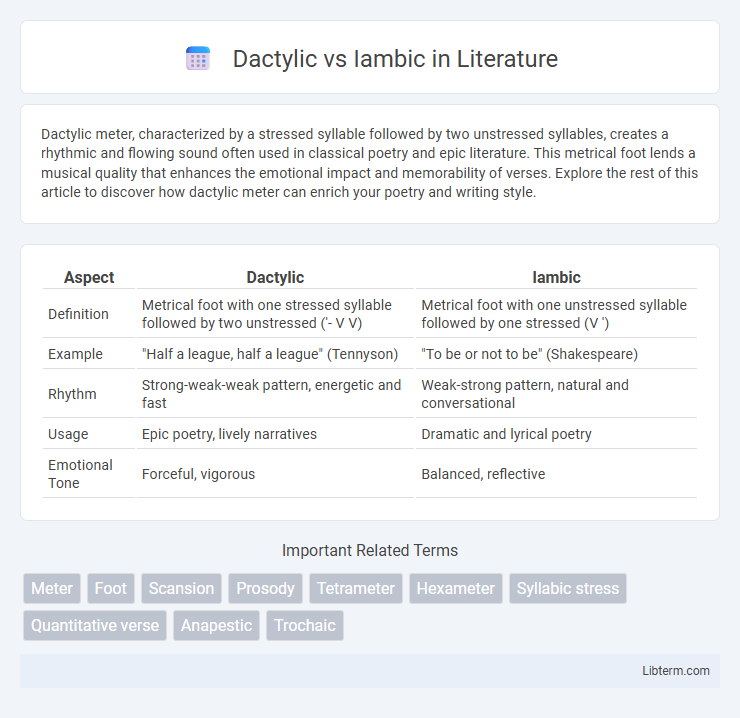Dactylic meter, characterized by a stressed syllable followed by two unstressed syllables, creates a rhythmic and flowing sound often used in classical poetry and epic literature. This metrical foot lends a musical quality that enhances the emotional impact and memorability of verses. Explore the rest of this article to discover how dactylic meter can enrich your poetry and writing style.
Table of Comparison
| Aspect | Dactylic | Iambic |
|---|---|---|
| Definition | Metrical foot with one stressed syllable followed by two unstressed ('- V V) | Metrical foot with one unstressed syllable followed by one stressed (V ') |
| Example | "Half a league, half a league" (Tennyson) | "To be or not to be" (Shakespeare) |
| Rhythm | Strong-weak-weak pattern, energetic and fast | Weak-strong pattern, natural and conversational |
| Usage | Epic poetry, lively narratives | Dramatic and lyrical poetry |
| Emotional Tone | Forceful, vigorous | Balanced, reflective |
Introduction to Dactylic and Iambic Meter
Dactylic meter consists of a stressed syllable followed by two unstressed syllables, creating a rhythmic pattern often used in classical poetry to evoke a lively or heroic tone. Iambic meter features an unstressed syllable followed by a stressed syllable, producing a natural, flowing rhythm commonly found in English verse and speech. Understanding these basic metrical feet is essential for analyzing poetic structure and appreciating the musicality of language.
Defining Dactylic Meter
Dactylic meter consists of a stressed syllable followed by two unstressed syllables, creating a rhythmic pattern often described as "DUM-da-da." This triple meter contrasts with iambic meter, which features alternating unstressed and stressed syllables in two-syllable feet, producing a "da-DUM" rhythm. Dactylic feet are less common in English poetry but provide a distinctive, flowing cadence that emphasizes a falling rhythm.
Understanding Iambic Meter
Iambic meter consists of alternating unstressed and stressed syllables, creating a natural, rhythmic flow common in English poetry, such as in Shakespeare's sonnets. This meter contrasts with dactylic meter, which features one stressed syllable followed by two unstressed syllables, producing a more galloping rhythm. Understanding iambic meter enhances appreciation of poetic structures and aids in identifying patterns that influence tone and mood in literary works.
Structural Differences: Dactyls vs Iambs
Dactylic meter consists of one stressed syllable followed by two unstressed syllables (- V V), creating a rhythmic pattern that feels rolling and energetic. In contrast, iambic meter features an unstressed syllable followed by a stressed syllable (V -), producing a steady and natural flow often found in English poetry. These structural differences influence the pacing and emotional tone of verse, with dactyls conveying a more dynamic cadence and iambs offering a balanced, conversational rhythm.
Historical Usage in Poetry
Dactylic and iambic meters have distinct historical applications shaping Western poetry, with dactylic meter prominent in ancient Greek and Latin epic poetry, as seen in Homer's "Iliad" and Virgil's "Aeneid." Iambic meter gained widespread use in English literature during the Renaissance, notably in Shakespeare's sonnets and blank verse plays, establishing it as the backbone of English poetic rhythm. The evolution of these meters reflects cultural shifts and linguistic preferences, influencing modern poetic forms and metrical experimentation.
Examples of Dactylic Meter in Literature
Dactylic meter, characterized by a stressed syllable followed by two unstressed syllables, appears prominently in Henry Wadsworth Longfellow's "Evangeline," where the rhythm creates a flowing, musical quality. Another classic example is Alfred Lord Tennyson's "The Charge of the Light Brigade," which uses dactylic trimeter to convey the galloping sound of horses during battle. These instances showcase how dactylic meter enhances the emotional and auditory impact of poetry.
Examples of Iambic Meter in Literature
Iambic meter, characterized by an unstressed syllable followed by a stressed syllable, is prominently featured in William Shakespeare's plays and sonnets, notably in "Shall I compare thee to a summer's day?" from Sonnet 18. Another classic example appears in the poetry of John Milton, particularly in "Paradise Lost," where iambic pentameter structures the epic's verses with rhythmic precision. This meter's natural flow closely mirrors English speech patterns, making it a preferred choice in English literary tradition.
Effects on Rhythm and Mood
Dactylic meter, characterized by a stressed syllable followed by two unstressed syllables, creates a rolling, lively rhythm that often conveys urgency or excitement. In contrast, iambic meter, with its pattern of an unstressed syllable followed by a stressed syllable, generates a steady, natural flow associated with calmness and reflection. The choice between dactylic and iambic meters significantly influences the mood of a poem, shaping readers' emotional responses through their distinct rhythmic patterns.
Choosing the Right Meter for Your Poem
Choosing the right meter for your poem depends on the emotional impact and rhythm you want to achieve. Dactylic meter, with its stressed-unstressed-unstressed pattern, creates a lively, driving cadence often suited for energetic or dramatic themes. Iambic meter, characterized by its unstressed-stressed pattern, provides a natural, flowing rhythm ideal for reflective or conversational tones.
Conclusion: Dactylic vs Iambic in Modern Writing
Dactylic meter, characterized by a stressed syllable followed by two unstressed syllables, infuses modern writing with a rhythmic urgency and melodic bounce, making it ideal for dramatic or lyrical content. Iambic meter, featuring an unstressed syllable followed by a stressed one, is prevalent in contemporary poetry and prose due to its natural, conversational flow and accessibility. Writers choosing between dactylic and iambic meters weigh the desired emotional impact and readability, with dactylics amplifying intensity and iambics promoting clarity and subtlety.
Dactylic Infographic

 libterm.com
libterm.com